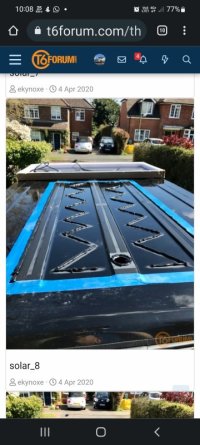What Solar Panel/controller Dc-dc Leisure Battery - Have You Got ?
- Thread starter Dellmassive
- Start date
DaveFuller
New Member
great, thanks for the quick replies. i'll look into the Lensun panel. is there a good thread about fixing panels to roofs someone can point me to? we've got a pop-top...Lensun do a 150w flexible panel that’s only 21 volts so that would work with the cetek.
More additional info on roof mounting

 www.t6forum.com
www.t6forum.com
.


Solar Panel: Cutting Hole in Roof !!!
im going fit a solar panel I’ve made sure all cables and connections are under the panel. As I hate to see them. Until it arrives I don’t know how high the connections make the panel sit off the roof ! It’s a HiLow roof. Inside is unfinished. I’ve got to drill cable holes anyway. So...
.

On a similar note, I've just discovered that a flexible solar panel Which is now stuck on my roof, was sold to me as having a voc of 21.2, but during installation the label was taken from the back, so the adhesive could bond direct to panel. The following day I'm reading the label and it states a voc of 23.4, I have a CTEK250 fitted.
Apart from my arguing this out with the seller what are my other solutions?
Apart from my arguing this out with the seller what are my other solutions?
Or go rigid.

 www.t6forum.com
www.t6forum.com

Another failed solar panel
After a second flexi solar panel failure, I'm going for a rigid type in the hope that it's a last time fit & forget job. The first flexi to fail was a generic chinese one factory fitted to the poptop by Reimo, that lasted around 2 years. The second one, which has just failed was a Carbest...
I was away last weekend with a 100W panel feeding a Redarc BCDC1240 and a 100Ah victron superpack, and whatever the fridge (Vitrifrigo TL48) took out overnight was replenished before I even got out of bed in the morning.
Solar Panel: Victron 175W
Mobile Panel: n/a
Solar charge controller: Victron SmartSolar MPPT 75/15
DC-DC charger: Sterling 30A
EHU Charger: Sargent (built-in)
battery bank: Numax 95Ah
Battery Monitor: BM2 (starter and Leisure)
Inverter: n/a
other:
Mobile Panel: n/a
Solar charge controller: Victron SmartSolar MPPT 75/15
DC-DC charger: Sterling 30A
EHU Charger: Sargent (built-in)
battery bank: Numax 95Ah
Battery Monitor: BM2 (starter and Leisure)
Inverter: n/a
other:
Solar Panel: NDS 200W LightSolar semiflexible - Rear Box
Mobile Panel: AllPowers 100watt panel (can charge solar generator as needed)
Solar charge controller: Victron MPPT 75/15
DC-DC charger: Victron Orion Smart 30A 12V DC to DC charger with Bluetooth
EHU Charger: Victron Energy Blue Smart IP22 12-Volt 30 amp 230V, Single Output Battery Charger
Battery bank: ULTIMATRON LiFePO4 12.8V 180Ah LX Smart BMS Motorhome battery sub seat
Battery Monitor: Victron Energy SmartShunt 500 amp Battery Monitor (Bluetooth) and Victron Energy Smart Battery Sense.
Inverter: Dometic/Waeco pure sine wave inverter MSI 1812T -1800 Watt
Other: H-TRONIC 1114530 MPC1000 Switch Station (allows me to switch from inverter to main supply without switching off inverter)
Other2: PowerOak AC200P Portable Power Station Solar Generator with 2000Wh LiFePO4 Battery 2000W Inverter(now used at home, but can be backup on long weeks away)
Mobile Panel: AllPowers 100watt panel (can charge solar generator as needed)
Solar charge controller: Victron MPPT 75/15
DC-DC charger: Victron Orion Smart 30A 12V DC to DC charger with Bluetooth
EHU Charger: Victron Energy Blue Smart IP22 12-Volt 30 amp 230V, Single Output Battery Charger
Battery bank: ULTIMATRON LiFePO4 12.8V 180Ah LX Smart BMS Motorhome battery sub seat
Battery Monitor: Victron Energy SmartShunt 500 amp Battery Monitor (Bluetooth) and Victron Energy Smart Battery Sense.
Inverter: Dometic/Waeco pure sine wave inverter MSI 1812T -1800 Watt
Other: H-TRONIC 1114530 MPC1000 Switch Station (allows me to switch from inverter to main supply without switching off inverter)
Other2: PowerOak AC200P Portable Power Station Solar Generator with 2000Wh LiFePO4 Battery 2000W Inverter(now used at home, but can be backup on long weeks away)
Last edited:
I swapped out my CTEK for a Renogy DC30S so I could connect a similar panel. It was a simple solution as all the wiring was in place from the CTEK and I just needed to connect the solar. I then sold the CTEK so it ended up being pretty cost effective. Renogy looks to be on offer just now on both 30A and 50A versions.On a similar note, I've just discovered that a flexible solar panel Which is now stuck on my roof, was sold to me as having a voc of 21.2, but during installation the label was taken from the back, so the adhesive could bond direct to panel. The following day I'm reading the label and it states a voc of 23.4, I have a CTEK250 fitted.
Apart from my arguing this out with the seller what are my other solutions?

DCC30S 12V 30A Dual Input DC-DC On-Board Battery Charger with MPPT
Explore the Renogy DCC30S 12V 30A DC to DC charger with MPPT for efficient and reliable power management in all conditions.
 uk.renogy.com
uk.renogy.com
The other option is to put a separate MPPT controller in.
DaveFuller
New Member
back to the forum with a variation on my question from yesterday. i've now been offered a Canadian Solar CS3l-345P residential panel for our van with the following specs:
Pmax : 345W
Vmp: 32.8V
lmp: 10.52A
Voc: 39.8V
lsc: 11.06A
massive overkill for our needs, but as it's free i'm going to take it. my plan is to get a Victron SmartSolar 100V 20A 48V MPPT as this seems to be the only Victron MPPT that can handle the 40V from the panel. Is this a good idea? is there anything else i should be thinking about?
my setup so far:
Victron Blue Smart IP22 charger
CTEK D250SE DC/DC charger
Hankook DC31MF Leisure battery - 100AH
thanks
Pmax : 345W
Vmp: 32.8V
lmp: 10.52A
Voc: 39.8V
lsc: 11.06A
massive overkill for our needs, but as it's free i'm going to take it. my plan is to get a Victron SmartSolar 100V 20A 48V MPPT as this seems to be the only Victron MPPT that can handle the 40V from the panel. Is this a good idea? is there anything else i should be thinking about?
my setup so far:
Victron Blue Smart IP22 charger
CTEK D250SE DC/DC charger
Hankook DC31MF Leisure battery - 100AH
thanks
No, the 48V is in relation to the output voltage of the solar controller (battery side), not the panel open circuit voltage. You want a 12V output. With that size of solar panel (345W) you’re going to want a sizeable controller such as the 100/30.back to the forum with a variation on my question from yesterday. i've now been offered a Canadian Solar CS3l-345P residential panel for our van with the following specs:
Pmax : 345W
Vmp: 32.8V
lmp: 10.52A
Voc: 39.8V
lsc: 11.06A
massive overkill for our needs, but as it's free i'm going to take it. my plan is to get a Victron SmartSolar 100V 20A 48V MPPT as this seems to be the only Victron MPPT that can handle the 40V from the panel. Is this a good idea? is there anything else i should be thinking about?
my setup so far:
Victron Blue Smart IP22 charger
CTEK D250SE DC/DC charger
Hankook DC31MF Leisure battery - 100AH
thanks
DaveFuller
New Member
it's 20kg, i was gonna mount at the back near the hinges.How heavy is that panel, you said you had a pop top so you want to make sure it’s not too heavy to effect the ease of lifting the pop top. You also might want to add a second leisure battery to benefit from 345W’s
a second battery would be good, i'm a bit space limited so will need to get the tape measure out and play kit tetris
I've been looking at solar recently and the new Renogy CIGS 150w panel has caught my eye...

 uk.renogy.com
uk.renogy.com
150w, bigger than a standard semi-flexible 150w but with vastly improved flexibility, 25y warranty, and much improved shading performance.
Anyone else considered these/have them already?
They're 646mm wide and 1658mm long, and after a quick measure of my roof, I reckon I'd be able to squeeze 2x on, side by side. It'd be REALLY tight mind you!
VOC on these is 24v (23.7v on the page specs but 24v on the pdf) which means with the added voltage at low temps, a pair would be just over the 50voc limit of the Renogy IP67 DC-DC charger. So when the time comes I'll probably order 1 of them to check the fitment, then if I want 2 I'll run in parallel, or get a separate MPPT controller.

Renogy 150 Watt CIGS Flexible Thin-film Solar Panel
150 watt solar panel, solar panel 150W, 150W solar panel,150 watt CIGS solar panel, 150W CIGS solar panel, CIGS 150W solar panel, 150W 12V solar panel, 150W Flexible panels
 uk.renogy.com
uk.renogy.com
150w, bigger than a standard semi-flexible 150w but with vastly improved flexibility, 25y warranty, and much improved shading performance.
Anyone else considered these/have them already?
They're 646mm wide and 1658mm long, and after a quick measure of my roof, I reckon I'd be able to squeeze 2x on, side by side. It'd be REALLY tight mind you!
VOC on these is 24v (23.7v on the page specs but 24v on the pdf) which means with the added voltage at low temps, a pair would be just over the 50voc limit of the Renogy IP67 DC-DC charger. So when the time comes I'll probably order 1 of them to check the fitment, then if I want 2 I'll run in parallel, or get a separate MPPT controller.
ollyollyolly
New Member
Hi did you order one, I’m converting but thinking something like this might be better but not many reviews uk based? Thanks PhilI've been looking at solar recently and the new Renogy CIGS 150w panel has caught my eye...

Renogy 150 Watt CIGS Flexible Thin-film Solar Panel
150 watt solar panel, solar panel 150W, 150W solar panel,150 watt CIGS solar panel, 150W CIGS solar panel, CIGS 150W solar panel, 150W 12V solar panel, 150W Flexible panelsuk.renogy.com
150w, bigger than a standard semi-flexible 150w but with vastly improved flexibility, 25y warranty, and much improved shading performance.
Anyone else considered these/have them already?
They're 646mm wide and 1658mm long, and after a quick measure of my roof, I reckon I'd be able to squeeze 2x on, side by side. It'd be REALLY tight mind you!
VOC on these is 24v (23.7v on the page specs but 24v on the pdf) which means with the added voltage at low temps, a pair would be just over the 50voc limit of the Renogy IP67 DC-DC charger. So when the time comes I'll probably order 1 of them to check the fitment, then if I want 2 I'll run in parallel, or get a separate MPPT controller.
No, sorry - I went for a 300w rigid panel mounted on a full size roof rack.Hi did you order one, I’m converting but thinking something like this might be better but not many reviews uk based? Thanks Phil
The fundamental problem with panels bonded to a roof, is the difference in expansion rates between the panel & roof. If the panel expands faster (it will, because it’s black & is the first thing the sun hits, it’s basically shading the roof & keeping it cooler) then the panel will try to buckle, because the roof is preventing it from expanding. Over the day, the roof warms up & expands. When the sun goes down, the panel is the first to shrink, but is being held back by the now expanded roof. The metal components in the roof shrink & cracks in the conductors start to form.
A panel that is mounted so it can float, will expand & contract independently of the roof, hence longer life. Plus rigid panels are glass, not plastic, so thermal movement is less.
A panel that is mounted so it can float, will expand & contract independently of the roof, hence longer life. Plus rigid panels are glass, not plastic, so thermal movement is less.
This is the reason why I mounted mine to 4mm twin wall and then bonded the twin wall to the roof with double sided tape, the panel is not affected by the roof warming at a different rate to the panelThe fundamental problem with panels bonded to a roof, is the difference in expansion rates between the panel & roof. If the panel expands faster (it will, because it’s black & is the first thing the sun hits, it’s basically shading the roof & keeping it cooler) then the panel will try to buckle, because the roof is preventing it from expanding. Over the day, the roof warms up & expands. When the sun goes down, the panel is the first to shrink, but is being held back by the now expanded roof. The metal components in the roof shrink & cracks in the conductors start to form.
A panel that is mounted so it can float, will expand & contract independently of the roof, hence longer life. Plus rigid panels are glass, not plastic, so thermal movement is less.
Similar threads
- Replies
- 2
- Views
- 190
- Replies
- 12
- Views
- 687
- Replies
- 33
- Views
- 969
- Replies
- 13
- Views
- 750
